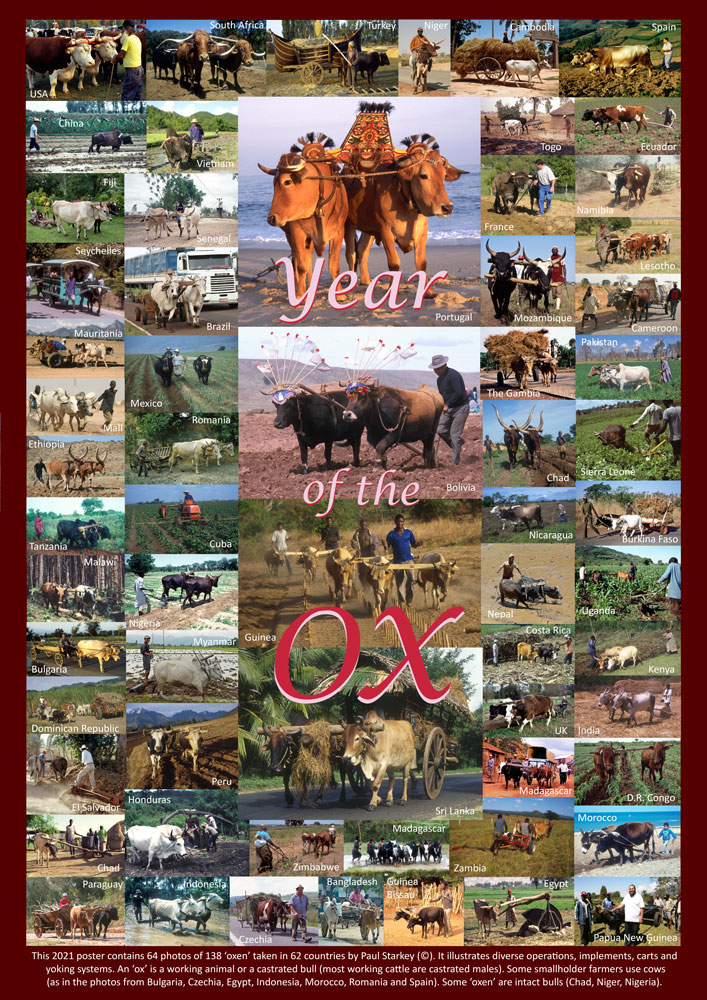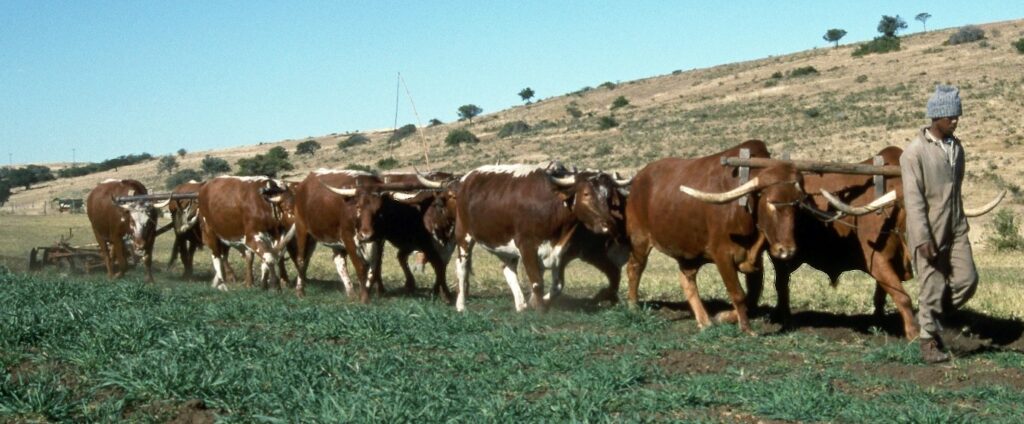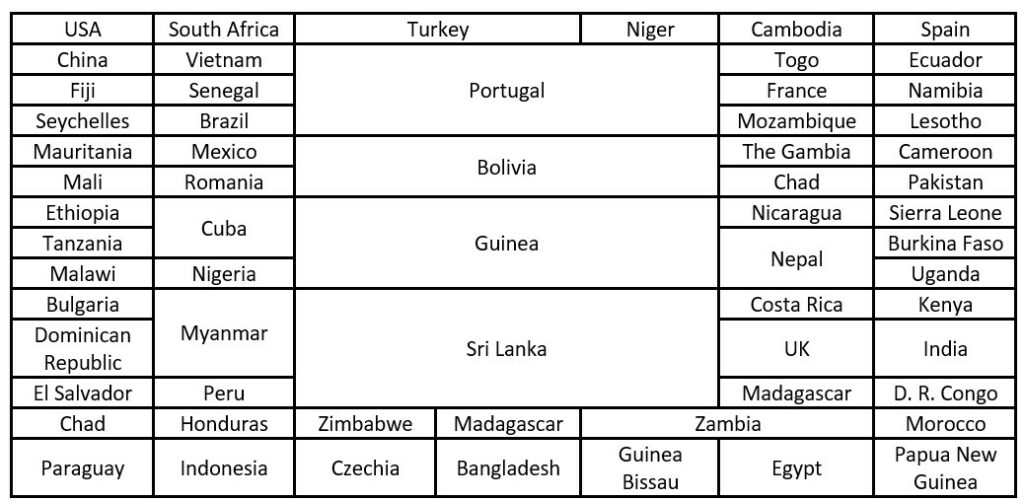Abstract:
A high-resolution educational poster has been created illustrating the use of working oxen in 62 countries. This portrays a wide variety of operations (including tillage, transport and post-harvest technologies) and harnessing systems (for single oxen, pairs and teams). While most work oxen are castrated cattle, some are cows or bulls. Some reasons for the decline in the use of work oxen are discussed, as are the requirements to allow long-standing, ecologically sustainable work oxen technologies to survive in modernising economies.
Résumé
Un poster éducatif haute résolution a été créée pour illustrer l’utilisation des bœufs comme animaux de trait dans 62 pays. Elle décrit une grande variété d’opérations (y compris les technologies de travail du sol, de transport et de post-récolte) et de systèmes de harnachement (pour un ou deux bœufs, ou en équipes). Alors que la plupart des bœufs utilisés sont des bovins castrés, certains sont des vaches ou des taureaux. Certaines raisons du déclin de l’utilisation des bœufs dans le travail de la terre sont discutées, tout comme les conditions qui permettraient à cette technologie ancestrale, écologiquement durable et à faible émission de carbone de survivre dans les économies en voie de modernisation.
Key words: Oxen, Animal Power, Animal Traction, Draft animals, Working animals, Yokes
To commemorate the Chinese Year of the Ox that started in February 2021, Paul Starkey has created a high-resolution educational poster (see Figure 1), using photographs he has taken in 62 countries to illustrate the diversity of using oxen for work. Paul is a member of AIMA and Visiting Senior Research Fellow at the Museum of English Rural Life, University of Reading. High resolution versions of the poster can be made available to AIMA members and not-for-profit organisations. It is currently available in English, French and Spanish versions. At the end of this article (Figure 5) is a key to make it easier to spot the photos relating to the various countries mentioned.

Oxen can be defined as working cattle or castrated bulls. Most of the work oxen in the world are indeed castrated bulls, as breeding populations of cattle always produce surplus males, making them readily available. Farmers, transporters and loggers using working cattle almost invariably use castrated males. In West Africa, farmers may buy young oxen from pastoralist herders (or traders), train them and work with them for a few years, before selling them on to the meat trade. Since the oxen double their weight in this time, the farmers make a capital gain: a rare example of an appreciating asset. However, when resources are scarce, smallholder farmers with intermittent need for work, cannot justify feeding oxen all the year. They therefore start to use cows, that can provide work, calves, milk and manure: a better return for the feed resources and the labour expended to keep them. The ‘oxen’ shown in some European countries (Bulgaria, Czechia, Romania and Spain) are cows used for light work. Working cows have also been commonly used for smallholder farming in North Africa, Turkey, Indonesia and the Altiplano of Bolivia. Art from the Pharaonic period of ancient Egypt shows yoked cows pulling plows. With good training, bulls can also be used for work, and working bulls are popular in some parts of the world including Chad, Niger, Northern Nigeria, Mexico and Cuba.
Oxen can be used for a wide variety of operations, with transport and soil tillage being the commonest. The poster shows oxen pulling two-wheel carts (eg, Bangladesh, Mauritania and Sri Lanka), four-wheel wagons (eg, Bulgaria, Brazil, Costa Rica and Paraguay) and sledges (Fiji and Namibia). Plowing in rain-fed soil with factory made implements is illustrated (eg, France, Kenya, Tanzania and UK) as is ridging (Chad and Nigeria). Tine-tillage and ridging using traditional wooden-beamed implements is shown for Bolivia, Ethiopia, Morocco and Peru. The use of factory-made tines is shown in Togo while upland harrowing is illustrated in Spain. Between-row weeding using either traditional or factory-made implements is shown in the Democratic Republic of Congo, Ecuador, Mexico, Pakistan, Sierra Leone, Uganda and Zimbabwe. Irrigated rice cultivation can involve oxen in various ways including trampling (Madagascar), tillage (China, Nepal) and levelling (Myanmar, Indonesia, Vietnam). Modern equipment is shown with pesticide spraying in Cuba and mowing in Zambia (with oxen-pulled motorised equipment). The use of oxen for irrigation is shown in Egypt with a sakia (or saqiyah) pump) and Senegal, where oxen pull a rope to raise water from a deep well. Post-harvest operations with work oxen include their use in threshing, illustrated by pulling a stone roller over harvested cereals in India. The use of oxen to mill oilseeds is shown in Chad, while in Honduras, oxen are seen milling sugar cane. Forestry logging with oxen in Malawi is illustrated, as is the use of oxen for grading roads in El Salvador. The training of small N’dama cattle as work oxen is shown in Guinea and Guinea Bissau and the exhibiting of heavy work oxen in USA is also illustrated.
Besides the diversity of operations, there is a wide variety of yokes and harnessing systems to see. There are broadly similar numbers of head yokes (tied behind the horns) and withers yokes (resting at the base of the neck) although the designs of these vary greatly and are often unique to particular areas. Collars are seldom used with oxen. Full collars and three-pad collars have been used to a small extent in UK and parts of central Europe and they have been trialled by researchers in other countries but have not become widespread (see Figure 2).

Most oxen are worked in pairs and some work singly. Teams of four oxen are illustrated in the poster (in Lesotho and South Africa), but much larger teams can be used to pull wagons or for soil tillage (see Figure 3).

There are two main types of oxen in the world, humpless cattle (Bos taurus) and humped cattle (Bos indicus) although many new breeds have been developed as hybrids derived from crossing the two species. Historically, Bos taurus breeds dominated Europe, North Africa and parts of West Africa (the home of the trypanotolerant N’dama cattle seen in the photos from Guinea, Guinea Bissau and Sierra Leone).
The importance of folk art and traditional designs can be seen in the special designs of decorated oxcarts used in Cambodia, Turkey, Madagascar and Sri Lanka, as well as the wagons typical of Bulgaria, Czechia, Romania and Paraguay. The heavy, carved, painted and plumed withers yokes of Portugal were widely used for yoking oxen for tillage and transport and also for pulling in fishing nets (in the example shown in the poster). A simpler, cheaper yoke would have worked just as well, and would probably have been more comfortable for the oxen, but the farmers might have felt less pride.
Depending on their local traditions, most farmers are adamant that their form of yoke (whether withers or head yoke) is superior, and the other type can be relatively cruel. However, there seems to have been little technology transfer between the users of the two principal yoke types within farming communities. In France there is a complex distribution pattern of traditional designs of head and withers yokes, with many neighbouring Départements having different yoking systems. The photo from Malawi shows an interesting exception. Malawians mainly use withers yokes, but for forestry applications they use head yokes as logging oxen descend slopes dragging heavy logs and head yokes provide better braking due to the rigid connection between the yoke and the animals.
Colonialists from various cultures have transferred the yoke designs they knew, and these have spread with the introduction of work oxen applications. In the Latin America, head yokes tied to the horns are widely used due to colonial Spanish and Portuguese influences. Most farmers and transporter in USA used withers yokes, while the Quebec yoke was tied to the horns. Dutch and British settlers brought the withers yoke to Southern and Eastern Africa, while the French introduced both head yokes and withers yokes into West Africa. All those international technology transfers were in the past 500 years, but for millennia, oxen with withers yokes have been widely used in most of Asia, North Africa and Ethiopia. The yoking examples seen in the photos from these regions are very similar to those used in historic times. The ox plow and yoke used in Egypt today is very similar to that seen in models and art from Pharaonic times (see Figure 4), although some Pharaonic art does suggest yokes were sometimes tied to the horns.

The photo from Morocco shows a cow yoked with a donkey. This is not ideal (they both have different strengths and stepping rates) but that farmer owns one cow and one donkey. Mixed teams are not unusual in North Africa. Different animals, including camels and horses, can be harnessed together, each fitted with an independent single withers yoke attached to a joining beam (sometimes referred to as a belly yoke) below animals. The implement attaches to this ‘belly yoke’.
Most ox carts in Madagascar are painted blue and decorated, and follow the design with good brake shoes introduced in the Napoleonic times. The poster photo from Seychelles shows ox carts being used to carry tourists to their hotels: a taxi would be cheaper, but the tourists pay a premium for the ‘traditional’ experience.
The use of oxen is still very important in many countries, although it is declining. In northern Europe and in the temperate zones of the Americas, heavy horses gradually replaced working oxen from the eighteenth century. Horses have good acceleration and walk faster and are preferred for frequent and specialised work (although military demand sometimes made farmers revert to using oxen). With industrialisation, horses and oxen were gradually replaced by tractors and other machine power, particularly on large farms that could afford the investments. On smallholder farms, animal power was retained, being available and affordable. However, in regions like southern Europe, reduction in household labour due to fewer children, children in school and adult family members seeking external full- or part-time employment made retaining work animals problematic. As smallholder farmers increasingly adopted tractors and pickup trucks, the critical mass needed to sustain animal power technologies (and associated folk art) diminished, so that support services making yokes, harnesses and implements gradually died out, making it increasingly difficult for individuals to rely on animal power.
Similar declines are now being seen throughout the world, exacerbated by the negative image often given to animal power in the media. As small tractors, motorcycles and three-wheelers are adopted, a critical mass develops, supported by new, local services. This reduces the demand for the different services supporting animal power, leading to a spiral of decline.
In industrialised countries, the economics of mechanisation was associated with land consolidation and increasing farm size. Smallholder farmers sold up to larger farms and joined the work force in rural or urban areas. Such processes continue in much of the world where land rights facilitate this. However, in many countries, including in much of sub-Saharan Africa, land ownership can be more complicated and associated with highly sensitive cultural traditions. Motorisation on rain-fed, small-scale farms may not be profitable, giving an economic advantage to animal power. However, people aspire to modernisation and motorisation, and politicians frequently respond with promises of subsidised tractor services. Across Africa there are ‘graveyards’ with strata of old tractors, each with different colours depending on the tractor make provided by each supporting development project. In many countries, those who continue to use work oxen face an additional problem of theft: with improved transport and road infrastructure it is becoming easier to steal and transport an ox and sell the meat in an urban outlet within a few hours. This is one reason why many farmers in Africa switched to using donkeys, that were less likely to be stolen (that is until the recent Chinese demand for ejiao made from the gelatine of donkey hides inflated the disposal value of donkeys).
In many countries, oxen are readily available and can provide an ecologically sustainable, low-carbon, local form of rural power. However, there is currently minimal research or support for animal power at national or international levels. Work animals need political and media champions to stress the advantages of the longstanding and well proven animal-powered technologies.

The Author

Paul Starkey is a Visiting Senior Research Fellow at the Museum of English Rural Life, University of Reading and a consultant in animal power, integrated transport and transport services.

Hello Paul,
You should come to Australia one day. The Australian bullock driver’s league would make you welcome.